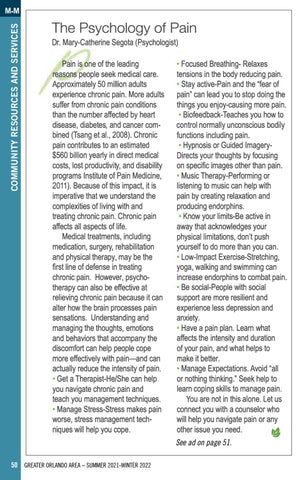COMMUNITY RESOURCES AND SERVICES
M•M
The Psychology of Pain Dr. Mary-Catherine Segota (Psychologist) Pain is one of the leading reasons people seek medical care. Approximately 50 million adults experience chronic pain. More adults suffer from chronic pain conditions than the number affected by heart disease, diabetes, and cancer com bined (Tsang et al., 2008). Chronic pain contributes to an estimated $560 billion yearly in direct medical costs, lost productivity, and disability programs Institute of Pain Medicine, 2011 ). Because of this impact, it is imperative that we understand the complexities of living with and treating chronic pain. Chronic pain affects all aspects of life. Medical treatments, including medication, surgery, rehabilitation and physical therapy, may be the first line of defense in treating chronic pain. However, psycho therapy can also be effective at relieving chronic pain because it can alter how the brain processes pain sensations. Understanding and managing the thoughts, emotions and behaviors that accompany the discomfort can help people cope more effectively with pain-and can actually reduce the intensity of pain. • Get a Therapist-He/She can help you navigate chronic pain and teach you management techniques. • Manage Stress-Stress makes pain worse, stress management tech niques will help you cope.
• Focused Breathing- Relaxes tensions in the body reducing pain. • Stay active-Pain and the "fear of pain" can lead you to stop doing the things you enjoy-causing more pain. • Biofeedback-Teaches you how to control normally unconscious bodily functions including pain. • Hypnosis or Guided Imagery Directs your thoughts by focusing on specific images other than pain. • Music Therapy-Performing or listening to music can help with pain by creating relaxation and producing endorphins. • Know your limits-Be active in away that acknowledges your physical limitations, don't push yourself to do more than you can. • Low-Impact Exercise-Stretching, yoga, walking and swimming can increase endorphins to combat pain. • Be social-People with social support are more resilient and experience less depression and anxiety. • Have a pain plan. Learn what affects the intensity and duration of your pain, and what helps to make it better. • Manage Expectations. Avoid "all or nothing thinking." Seek help to learn coping skills to manage pain. You are not in this alone. Let us connect you with a counselor who will help you navigate pain or any other issue you need. See ad on page 51.
50 GREATER ORLANDO AREA – SUMMER 2021-WINTER 2022
ti








